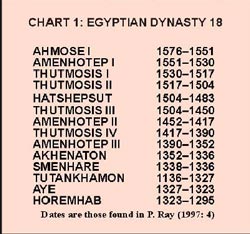https://biblearchaeology.org/
Queen Hatshepsut of Dynasty 18. Was she Pharaoh’s daughter? - D. Hansen.
Egyptian records show that Thutmosis II and Hatshepsut had a daughter, but they had no sons. He did have a son by a secondary wife. This son, Thutmosis III, was to become the next Pharaoh. When Hatshepsut’s husband/half-brother, Thutmosis II, died ca. 1504 BC, Hatshepsut was 29-30 years old. She then reigned as co-regent with her infant stepson, Thutmosis III. Thutmosis III’s exact age when his father died is unrecorded:
but given that he [Thutmosis III] reigned over 50 years and that his mummy was not that of an elderly man, we can deduce that he was a young child or even a baby rather than a teenager (Tyldesley 1996:96).
The co-regency lasted 22 years until Hatshepsut died ca. 1483 BC after which time Thutmosis III assumed the sole leadership of Egypt and ruled for another 33 years.
An intriguing question is how did Hatshepsut assume power, keep it for so long and defy tradition, as well as why the male bureaucracy tolerated this aberration? There are numerous theories that try to answer that question. The most probable explanation is that she,
possessed a strong character and made the most of the power that had accrued to her as regent. On a practical level, we can imagine that when she became regent she carefully chose the officials who were to serve her (Robins 1993:47).
P. Clayton records that “Hatshepsut was a strong-willed woman who would not let anyone or anything stand in her way” (1994:104). Thutmosis II, her husband/half-brother, was known to be in poor health, frail, and “far from energetic” (Tyldesley 1996:82). She may have anticipated his early death and, at age 29 or 30, had ample time to prepare for taking the throne. Although she was supposed to only be co-regent with her stepson, her aspiration to become Pharaoh was soon apparent. By year seven of her reign she had abandoned the title and insignia of a queen and adopted the fivefold titulary and male costume of a king, including an official royal false beard (Carter 1994:105). She also began to assert kingly prerogatives by setting up obelisks and making offerings directly to gods (Robins 1993:46).
Moses, Hatshepsut and Dynasty 18
...Hatshepsut died ca. 1483 BC and Thutmosis III reigned alone for another 33 years. Whether Hatshepsut died a natural death, or was murdered, is disputed by Egyptologists. What is known is that many of Hatshepsut’s monuments and statues were defaced or destroyed after her departure. Her name was erased from cartouches across the land and replaced with the names of her father or husband/half-brother (LoMusio 1989:87). This would indicate that Thutmosis III acquiesced to removing her memory, understandable if he had had to play a secondary role to her during the first 22 years of his reign. Davis agrees with this interpretation and writes that,
the vengeance sought upon Moses was not due only to Moses’ murder of an Egyptian official, but also to his possible association with Hatshepsut (1986:42).
...Of the monuments that attest to Thutmosis III’s deeds are two obelisks found at Heliopolis. One of these, popularly known as “Cleopatra’s Needle,” can now be seen in Central Park, behind the Metropolitan Museum of Art, in New York City (why this obelisk is associated with Cleopatra, ca. 50 BC or 1800 years after Thutmosis III, is not clear). From the tomb of Rekhmire, vizier or a high officer under Thutmosis III, paintings show foreign slaves making bricks. Aling contends these are the only depictions of brickmaking in all the hundreds of tomb paintings from the New Kingdom period, a time that includes the reign of Ramses II of the next dynasty, 19 (1983:71). If Hatshepsut was “Pharaoh’s daughter,” then these building programs were ongoing at the time Moses was raised in Egypt; another element that supports the Biblical story.
...it is interesting to put my proposal for Moses’ life over Dynasty 18 and correlate the dates to various Egyptian personages. A careful review of Chart 3 shows that the Biblical account and the Pharaohs of Dynasty 18 fit very neatly.
Dynasty 18 and Dynasty 19 Compared



No comments:
Post a Comment